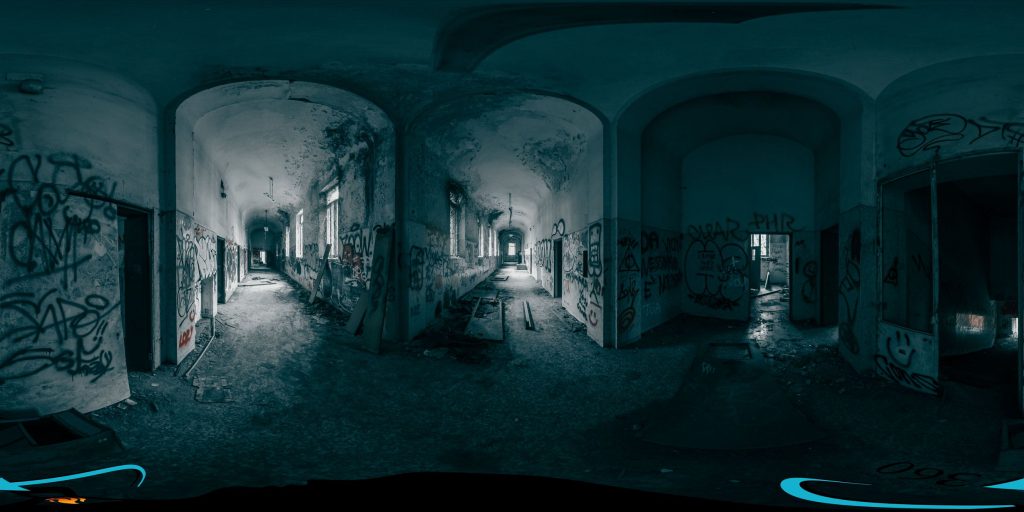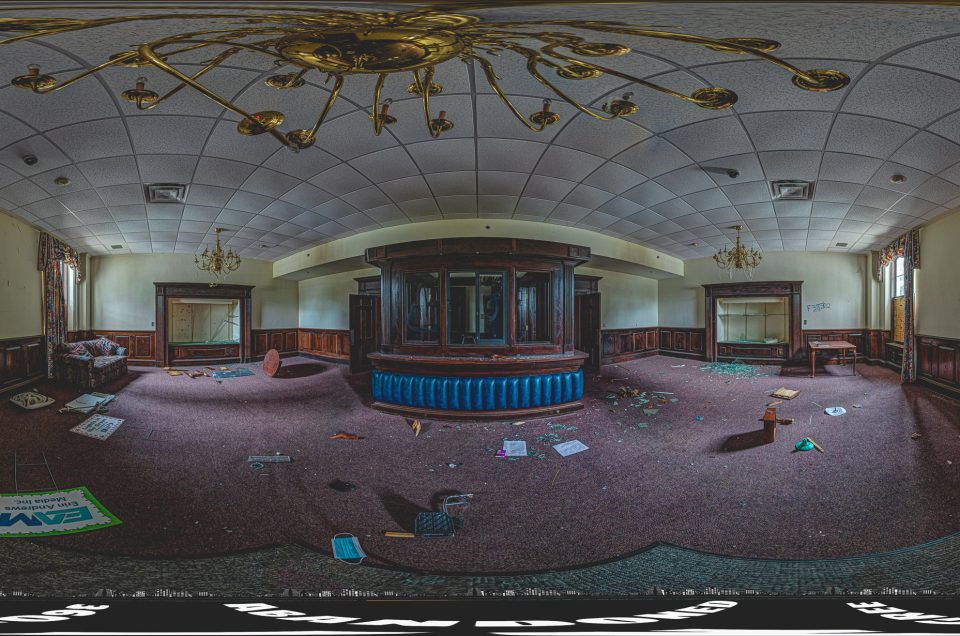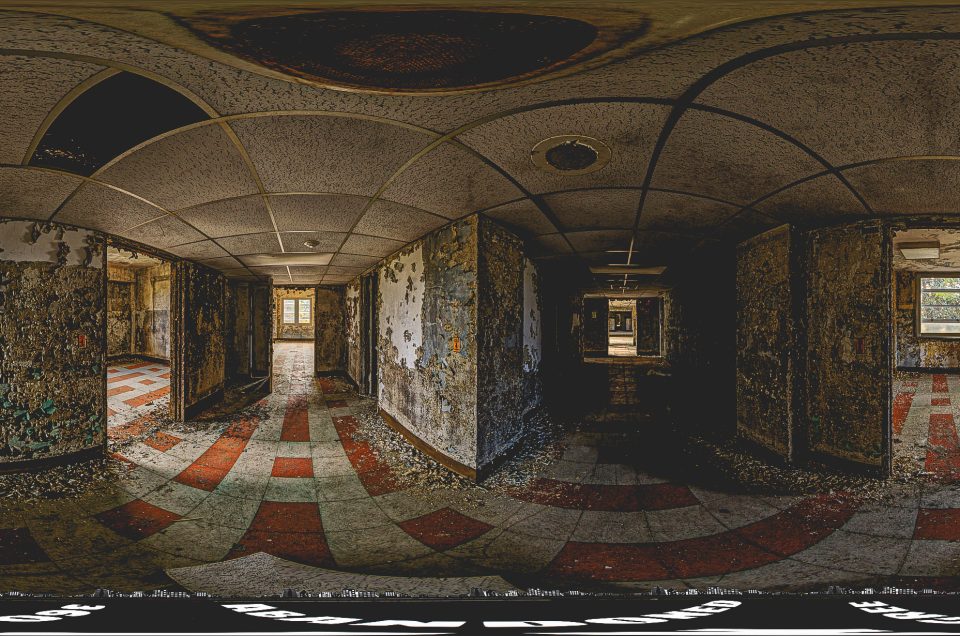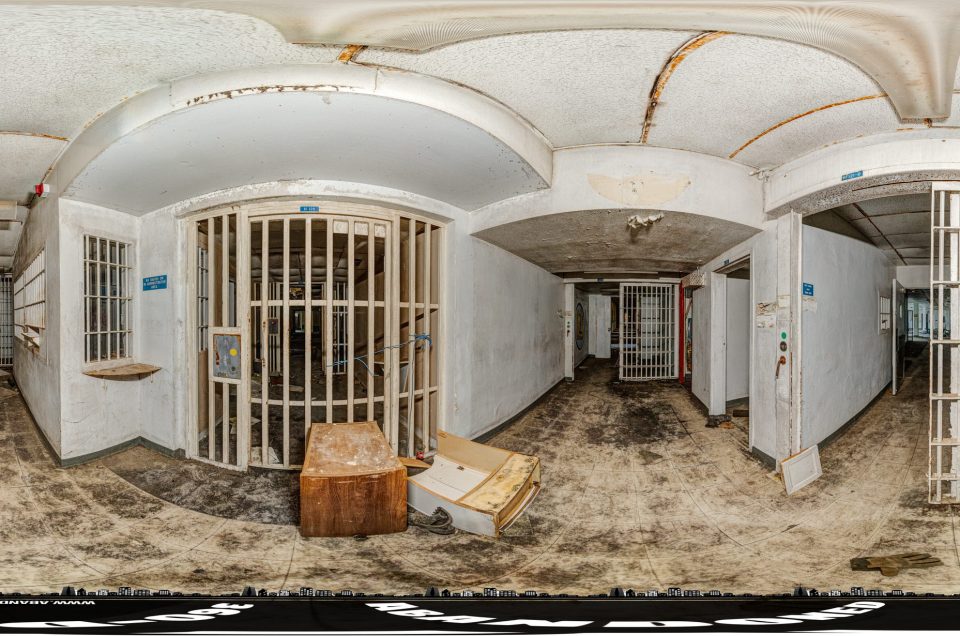Exploring the Shadows of Mombello Psychiatric Hospital: A URBEX Adventure in Italy’s Forgotten Asylum
Explore the Mombello Psychiatric Hospital in Italy, a hauntingly intriguing location that urban explorers will appreciate for its history, architecture, and atmosphere. This former mental health complex, now abandoned, stands as a powerful reminder of Italy’s past approaches to psychiatric care and offers a rare glimpse into decaying corridors, weathered rooms, and overgrown exterior spaces that have been reclaimed by time.
Take a look at the Mombello Psychiatric Hospital in Italy through the amazing 360-degree panoramic images on Google Maps Street View below, which allow you to virtually move through parts of the property. These immersive views are perfect for URBEX enthusiasts who want to study the site’s layout, textures, and unique details before planning content or learning more about this once-active institution.
Photo by: Simone Scaravella
Photo by: Simone Scaravella
Photo by: Simone Scaravella
Photo by: Insolito Cinema
Photo by: Insolito Cinema
Photo by: Insolito Cinema
Photo by: Insolito Cinema
Photo by: Insolito Cinema
Photo by: Insolito Cinema
Photo by: Simone Scaravella
Venturing into the Heart of Abandoned Italy
Hey there, fellow adventurers! If you’re anything like me, the thrill of stepping into forgotten places sends a rush through your veins. Picture this: crumbling walls whispering secrets of the past, overgrown paths leading to hidden chambers, and an atmosphere thick with mystery. That’s exactly what awaits at Mombello Psychiatric Hospital, a sprawling relic abandoned in Italy that’s become a magnet for urban exploring in Italy. As URBEX enthusiasts, we chase these spots not just for the adrenaline, but for the stories they hold—tales of human struggle, innovation, and eventual silence.
Located in Limbiate, near Milan in the Lombardy region, Mombello Psychiatric Hospital stands as one of the most captivating sites for those daring enough to explore abandoned in Italy. Once the largest asylum in the country, covering a massive 40,000 square meters, it now lies in ruins, its medieval-style buildings forming what feels like a lost village frozen in time. In this post, we’ll dive deep into its history, from its construction and bustling operations to the reasons it was left behind. We’ll uncover its activities, historical significance, and why it’s a must-visit for URBEX fans. Grab your flashlight and sturdy boots—let’s uncover the enigmas of Mombello Psychiatric Hospital together.
As we journey through this account, I’ll keep things friendly and packed with details to fuel your next expedition. Whether you’re planning your first urban exploring in Italy trip or adding to your list of abandoned in Italy gems, this guide will arm you with knowledge to make your visit unforgettable. Remember, safety first in URBEX—respect the site, leave no trace, and always go with a buddy.
The Birth of a Giant: Construction and Opening of Mombello Psychiatric Hospital
The story of Mombello Psychiatric Hospital begins in the mid-19th century, a time when Italy was unifying and facing massive social changes. Constructed between 1873 and 1878, the hospital was built around an existing 18th-century villa known as Villa Pusterla-Crivelli, which dated back to 1754. Architect Francesco Croce designed the expansions in a medieval style, transforming the property into a self-contained complex that resembled a small fortified town. This wasn’t just any building project; it was a response to urgent needs in psychiatric care.
Operations kicked off earlier than the official inauguration. In 1865, about 60 patients were transferred from the overcrowded Senavra asylum in Milan to the villa in Mombello. By 1867, the patient count had grown to 300, with equal numbers of men and women housed separately. The grand opening came in 1878, marking the start of its role as the Giuseppe Antonini Psychiatric Hospital of Limbiate. This made it a pioneer in modern Italian psychiatry, blending old-world architecture with emerging ideas in mental health treatment.
Why here? The location in Mombello offered fresh air, open spaces, and isolation from urban chaos—ideal for what was initially planned as an agricultural colony for calm patients. Experts like Cesare Castiglioni, Andrea Verga, and Serafino Biffi from Milan’s Psychiatric School spearheaded the project. They envisioned a place where patients could heal through nature and work, far from the grim confines of older institutions. For URBEX explorers today, wandering these grounds feels like stepping back to that era, with towering structures and walled perimeters evoking a sense of ancient fortitude.
Imagine arriving at the gates during your urban exploring in Italy adventure. The sheer scale hits you first—22 buildings sprawled across hectares of land, now overtaken by vines and decay. As you push through, remnants of the original villa peek out, a reminder of how this site evolved from a noble estate to a beacon of hope for the mentally ill. Abandoned in Italy for decades, it’s a perfect canvas for photographers and storytellers in the URBEX community.
A Century of Care: Operating Duration and Daily Activities at Mombello Psychiatric Hospital
Mombello Psychiatric Hospital operated for an impressive 113 years, from 1865 until its official closure in 1978. But the full wind-down took longer; the last long-term patients weren’t discharged until 1999, stretching the total span to over 130 years of influence. During its peak, it housed over 3,000 individuals, making it not just a hospital but a micro-society.
What went on inside? Activities were diverse and forward-thinking for the time. Patients were categorized by behavior rather than diagnosis: the “Quiet Ones” enjoyed relative freedom, the “Agitated Ones” were isolated for safety, the “Filthy Ones” received specialized hygiene care, and the “Workers” engaged in occupational therapy. This “working therapy” was central—patients tilled gardens, crafted goods in workshops, and even built infrastructure like roads and an aqueduct that supplied water to the nearby town of Limbiate.
Under directors like Edoardo Gonzales in the late 1800s, the hospital introduced cultural elements to promote “moral education.” Theatrical shows, dances, and music sessions filled the halls, helping patients connect with each other and the world outside. Gonzales also set up a children’s department with Montessori-style education, where kids of patients or staff learned in a nurturing environment. By the 1920s, Giuseppe Corberi and his daughter Elisa expanded this, turning it into a model for child care within psychiatric settings.
Scientific pursuits thrived too. Labs for pathological anatomy, biology, and experimental psychology dotted the campus. In 1922, Ugo Cerletti directed the neurobiological research institute here, later inventing electroconvulsive therapy (ECT)—a controversial but groundbreaking treatment. A university clinic for nervous and mental diseases operated from 1931 to 1943, training doctors and advancing knowledge.
For urban explorers in Italy, these details paint a vivid picture of what you’ll encounter. Picture slipping into the old laboratories during your URBEX outing—dusty beakers and faded charts hinting at experiments long forgotten. Or the theater spaces, where echoes of past performances might still linger in the air. Abandoned in Italy since the late 20th century, these areas offer a tangible link to the hospital’s vibrant past, blending education with the eerie thrill of decay.
World Wars added layers to its operations. During World War I, under Giuseppe Antonini (for whom the hospital is named), pavilions became military hospitals treating soldiers’ psychological traumas. Over 600 soldiers arrived in the first year alone, receiving rest therapy, nutrition plans, and work assignments without restraints like straitjackets. The hospital also sheltered refugees after the Battle of Caporetto and during World War II, plus flood victims in 1951. These humanitarian efforts underscore its role beyond psychiatry, as a refuge in times of crisis.
In the post-war era, overcrowding became a challenge, leading to satellite branches in nearby towns. Yet, innovation continued: art therapy flourished, with patients creating works that earned the nickname “The Brera of Mombello” after Milan’s famous art district. Journalist Antonio Curti visited in 1915, capturing internees’ wartime thoughts in articles. The hospital even published its own gazette from 1880 to 1905, detailing admissions, health tips, and internal news.
As you navigate the overgrown paths on your urban exploring in Italy quest, these stories bring the ruins to life. Each pavilion tells a tale—of healing, hardship, and humanity. URBEX here isn’t just about the visuals; it’s about feeling the pulse of history in every cracked tile and shadowed corridor.
Shadows of Conflict: Historical Significance and Notable Events
Mombello Psychiatric Hospital’s historical significance can’t be overstated. As Italy’s largest asylum, it symbolized the shift from punitive to therapeutic mental health care, influenced by Philippe Pinel’s village-model ideas. Its expansions—adding pavilions, churches, and labs—reflected evolving psychiatry, from agricultural colonies to research hubs.
Key events highlight its impact. In 1797, before becoming a hospital, the villa hosted Bonaparte family members, tying it to Napoleonic history. During WWI, its military role advanced trauma treatment, with soldiers gaining weight and stability through humane methods. The Bergonic chair for electric therapy treated psycho-neurotic cases, a precursor to modern approaches.
Notable figures add intrigue. Gaetano Perusini, who worked with Alois Alzheimer on Alzheimer’s disease, served here before his 1915 death in combat. Ugo Cerletti’s ECT work started on-site. Perhaps most poignant: Benito Albino Dalser, Benito Mussolini’s secret son, was interned and reportedly induced into a coma with insulin, dying under mysterious circumstances.
The hospital attracted global attention, with visitors from Europe and beyond studying its methods. It participated in exhibitions, showcasing patient art on topics like pellagra. Post-closure investigations in 1979 revealed preserved body parts and chemical traces, sparking debates on ethical practices.
For URBEX adventurers, this significance amplifies the allure. Abandoned in Italy, Mombello stands as a monument to psychiatric reform, its walls holding echoes of progress and pain. Exploring here connects you to broader narratives—Italy’s unification, wars, and the fight for mental health rights.
The Fall into Silence: Reasons for Abandonment
By the 1970s, winds of change swept Italy’s mental health system. The pivotal reason for Mombello Psychiatric Hospital’s abandonment was the 1978 passage of Legge Basaglia, or Law 180. Named after psychiatrist Franco Basaglia, this groundbreaking legislation mandated closing all psychiatric hospitals, shifting care to community-based services. It aimed to end institutionalization’s abuses, promoting dignity and integration.
Mombello, as the last to shut down, officially closed in 1978. However, discharging over 3,000 patients took time—full evacuation finished in 1999. Overcrowding, outdated facilities, and shifting societal views on mental illness sealed its fate. No longer needed, the site was left to nature’s reclaim.
Today, parts are owned by local authorities, with some buildings repurposed for schools, senior centers, and halfway houses. But much remains derelict, a paradise for urban exploring in Italy. URBEX here reveals the abandonment’s raw impact—vandalism, decay, and remnants like old medical equipment stirring a mix of awe and melancholy.
URBEX Tips: Preparing for Your Adventure at Mombello Psychiatric Hospital
Ready to tackle Mombello on your urban exploring in Italy itinerary? This abandoned in Italy hotspot demands respect and preparation. First, access: The site is partially restricted, so check local laws—trespassing can lead to fines. Enter via less obvious paths, but avoid forcing entry.
What to expect: Vast grounds with 22 buildings, including the villa, pavilions, and church. Highlights include the labs (watch for hazardous materials), theaters (great for photos), and gardens now wild. The atmosphere? Eerily quiet, with wind rustling through broken windows creating ghostly sounds.
Safety gear: Sturdy shoes for uneven terrain, gloves for sharp edges, masks for dust/mold, and a headlamp for dark interiors. Weather can turn; rain makes floors slippery. Go in groups—solo URBEX here risks getting lost in the maze-like layout.
Capture the essence: Document murals from patient artists, faded signs, and architectural details. But remember, take only pictures. Ethical URBEX preserves sites for future explorers.
Potential dangers: Structural instability, wildlife, and occasional patrols. If you spot asbestos or chemicals, steer clear. For thrill-seekers, nighttime visits amp the adventure, but daylight offers safer navigation.
Mombello isn’t just ruins; it’s a portal to Italy’s psychiatric past. Your visit could inspire stories shared in URBEX forums, connecting you to a global community.
Echoes of the Past: Modern Legacy and Cultural Impact
Even abandoned, Mombello Psychiatric Hospital influences culture. It featured in the 2017 film “7 Days, 7 Girls” with Johnny Depp, and inspired the 2013 theater project “Mombello. Voci da dentro il Manicomio,” based on artworks and testimonies. Photographers like Nicola Vicini have captured its melancholy, evoking patient despair.
Preservation efforts include university projects for redevelopment, potentially a museum. This balances history with progress, ensuring its legacy endures.
For urban explorers in Italy, Mombello represents the ultimate URBEX challenge—blending danger, discovery, and depth. Abandoned in Italy, it reminds us of forgotten lives and the evolution of care.
Conclusion: Your Call to Adventure at Mombello Psychiatric Hospital
As we wrap up this deep dive into Mombello Psychiatric Hospital, I hope you’re buzzing with excitement for your next URBEX escapade. From its 1873-1878 construction and 1865 opening to its 1978 closure under Legge Basaglia, this site encapsulates a century of psychiatric history. Its activities—therapy, research, wartime aid—and significance as Italy’s largest asylum make it more than ruins; it’s a narrative waiting to be experienced.
Whether you’re drawn to abandoned in Italy spots for the history or the heart-pounding exploration, Mombello delivers. Urban exploring in Italy doesn’t get much richer. So, plan your trip, stay safe, and let the adventure unfold. Who knows what secrets you’ll uncover in those shadowed halls?
If you liked this blog post, then you might be interested in learning about the abandoned Southwest Elementary School in Georgia, the Puerto Ferro Lighthouse in Puerto Rico, or the Harry T. Moore & Harriette Moore Home in Florida.

A 360-degree panoramic image inside the abandoned and decaying Mombello Psychiatric Hospital in Italy. Photo by: Insolito Cinema
Welcome to a world of exploration and intrigue at Abandoned in 360, where adventure awaits with our exclusive membership options. Dive into the mysteries of forgotten places with our Gold Membership, offering access to GPS coordinates to thousands of abandoned locations worldwide. For those seeking a deeper immersion, our Platinum Membership goes beyond the map, providing members with exclusive photos and captivating 3D virtual walkthroughs of these remarkable sites. Discover hidden histories and untold stories as we continually expand our map with new locations each month. Embark on your journey today and uncover the secrets of the past like never before. Join us and start exploring with Abandoned in 360.
Do you have 360-degree panoramic images captured in an abandoned location? Send your images to Abandonedin360@gmail.com. If you choose to go out and do some urban exploring in your town, here are some safety tips before you head out on your Urbex adventure. If you want to start shooting 360-degree panoramic images, you might want to look onto one-click 360-degree action cameras.
Click on a state below and explore the top abandoned places for urban exploring in that state.








